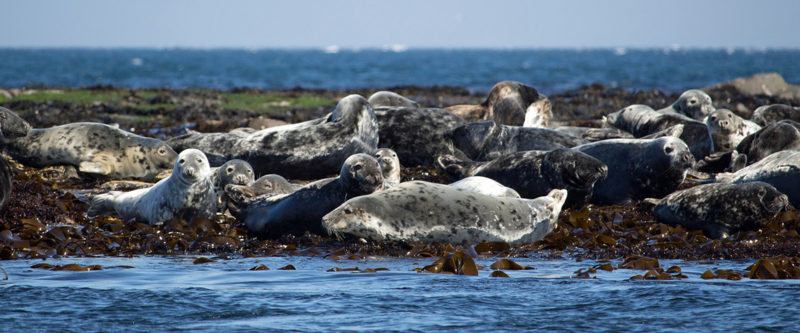by Emily Hasler
I enter the water on the wide stage of Carbis Bay. I swim out slowly beyond my depth, stop and float on my back as is my habit. It is then I realise I am being watched. The seal comes closer, dips, hunching its shoulders like a cat about to pounce, before diving gently again. Closer. Those unblinking eyes and sharp whiskers becoming more and more distinct. It made contact—eye contact. And in that moment I was suddenly aware of my feet—everything fell inside me and beneath me and I began to pedal, suddenly feeling utterly terrestrial.
***
The Latin name for the Grey or Atlantic seal is Halichoerus grypus, meaning ‘hook-nosed sea-pig’. Those mannerisms and whiskers—which are super sensitive and allow seals to hunt successfully even if blind—are feline, but the profile of a grey seal is most often called canine. Then again, another name is the horsehead seal. The young are pups, or calves. They breed in rookeries. Their nearest land relatives are bears or mustelids (weasels, otters, badgers, etc.). The old Orkney word for the grey seal is ‘haaf fish’, literally meaning ‘fishing fish’, highlighting the tense relationship between the two parties. But it also sounds like ‘half fish’ and recalls Trinculo’s discovery of Caliban in Scene II of the Tempest:
[…] What have we
here? a man or a fish? dead or alive? A fish:
he smells like a fish; a very ancient and fish-
like smell; a kind of not the newest Poor-
John. A strange fish! […]
More often still than any of the other beastly comparisons, seals are likened to ourselves. Their eyes especially, which are actually completely unlike ours, but that look in a way that is familiar, knowing—even accusing. Where other animals might see us, they look. And not, like a horse, with a seemingly submissive nod, but eye to eye. This is what happened. I was swimming and the seal knew it. It came towards me and then it came closer.
***
The tail of a seal is not a tail, but feet. It is as if their legs had been bagged and tied together. We can see this in photos of them reclining on their backs, nonchalantly crossing their flipper-feet. Seals belong to the family of pinnipeds; pinna for fin and pedis for foot. Finned and footed, they are different animals on and off land. The sea-slick grey seal is pebbled, glossy. On land she is dulled and mottled. From this shape-shifting has grown stories of selkies; tales of love, vengeance and transgression, of crossing between worlds. For, like cetaceans, seals have returned to the sea, performing an elegant loop in evolution. Here’s R.M. Lockley in his tender and still useful 1966 book Grey Seal, Common Seal:
The structure of the skeleton and limbs of the seal show that they once lived terrestrially with four articulate limbs able, like the polar bear and otter today, to walk about on dry land. Having become land mammals with man, they are returning, have almost completely returned, to the sea – which may yet be man’s not too distant future when the land fails to satisfy his requirements and if he continues to destroy his environment through lack of foresight.
This is one of the UK’s largest wild mammals; adult males are about 7ft long and 500lb but can be bigger in their prime. I suspect the individual I met with was female, slightly smaller but, toe-to-toe, surely taller than me. But we were not standing, and the sense I had is not of being outsized but of being out of my element. My eyesight underwater, even with prescription goggles, is pretty useless. My sense of smell is blunt, everything is overpowered by salt. I have no whiskers—though I do think I sensed being watched before I spotted my watcher. The seal knew about me being in the water long before I knew about it and came to investigate the trespasser.
***
Back in Essex, I recount my adventures with the seals again and again: how I took the train and saw the bay studded with seal-like shapes I took for buoys. How I swam the first day and thought I saw a log being washed ashore. How all these returned to me as seals when on my second day I ran into the water under a rainbow and one of the buoys sprouted whiskers, grew eyes and began to move towards me.
It could not be told enough. It could not be told. So I read.
“Did you know there are less grey seals in the wild than African elephants?”
“Fewer,” my friend replied.
“Yes, fewer. But I saw loads of seals, and no elephants at all!”
The UK has about 40% world’s population of grey seals. Although persecution has lessened, it does still go on. Microplastics work their way through the food chain to the bellies of apex predators while ghost nets attack them from without. When we encounter animals it is difficult to remember their endangeredness. Their scarcity makes them more vivid, causes them to occupy more space. How can we see what is no longer there to be seen? How do we spot what is missing? I keep butting up against this thought, just as I keep coming close to but not reaching my encounters with the seals—not touching.
***
On my last morning in Cornwall I decided not to swim. Instead I sat with my tea on a low but sheer cliff. In the pre-dawn light everything is temporarily vibrant, more distinct. A group of grey seals complicate the blue-black water, appearing as slightly darker blue-black flecks. There are at least a dozen, maybe twenty. It is hard to keep count as they appear and disappear across my field of vision. They seem to be acting as a group, coming together in pairs or threes and forming a loose assembly, sometimes ‘logging’ (lying lengthways), sometimes bobbing vertically (‘bottling’). Research on fur and elephant seals show they sleep with half a brain at a time in the water, while on land they sleep full-brained as humans. They dive and surface in their slumber, dropping to the bottom and then swimming up unconsciously to breath every seven minutes or so.
This Cornish colony of seals is easier to observe in the winter because their numbers in the bays increase. This morning it is as though they huddled together in the lee of the cliffs. The ‘as thoughs’ and ‘apparentlys’ proliferate, but something tells me to trust my animal sense; warmth, security, shelter. We can’t avoid the fact that when we encounter animals a human is always involved. We can’t take ourselves out of the situation. But we also can’t remove the other, the animal. In the exchange we ourselves become animalled. At several points I think one of the seals has spotted me, seeming to stop and stare back. I raise my flask in acknowledgement.
***
We need encounters with wildness to know that we cannot reach it. We need to butt up against that gap (which we feel in the belly, not the head) every once in a while. Documentaries are wonderful, but incredible underwater images won’t do it—they bring us too close. We talk of feeling so close we ‘could touch it’; what we need to remember is not touching, not reaching. There are so many necessary impossibilities to be tackled. We need myths and folklore, stories of meetings and crossings. We need to complicate our understanding, to be aware of our closeness and profound distance.
Of course there are some simple mammalian similarities. The same ventral fat which causes the sleeping seal to roll onto its back gives me my natural buoyancy. It is what lets me bob about in the waves as I love to do, allowing my body pivot slowly according to the tides and currents. I bask and swim lazy strokes, delighting in the water. But there is also, always, fear, even here in my own lonely North Sea. For each time I enter the water I am not quite alone. I catch grey shapes from the corner of my eye and my body plummets through itself before I realise it is just a gull, or a buoy.
Emily Hasler’s debut poetry collection, The Built Environment, was published by Pavilion Poetry in 2018. She was born in Suffolk but has washed up on the Essex-side of the river Stour. She works as a freelance proofreader and writer, and in a pub.
References
R.M. Lockley, Grey Seal, Common Seal (London: Andre Deutsch, 1966).

